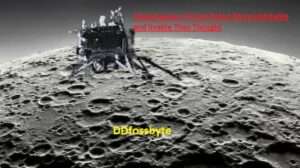For generations, the moon has captivated humanity’s imagination as a distant and mysterious celestial body. Recent revelations from Chandrayaan-3, India’s lunar mission, have added a new layer of intrigue to our lunar neighbor. Contrary to earlier beliefs, Chandrayaan-3 has unveiled data suggesting that the moon might be more habitable and hospitable than previously imagined. Let’s dive into this exciting discovery.

India’s Chandrayaan-3 mission has found that the moon is more habitable than previously thought. The mission’s lander, Vikram, and rover, Pragyan, have been collecting data on the moon’s surface for few days, and the results are pointing to a more hospitable environment than previously believed.
Water, Water Everywhere
One of the most startling findings from Chandrayaan-3 is the prevalence of water on the moon. Scientists have long suspected the existence of water in the moon’s polar regions, but the latest data provides compelling evidence. Water is a fundamental element for life as we know it, and its presence on the moon opens up intriguing possibilities for future lunar exploration.
Potential for Sustained Life
The discovery of water on the moon has profound implications. While the lunar surface remains harsh and inhospitable to humans due to extreme temperatures and the lack of a breathable atmosphere, the presence of water offers a glimmer of hope. Water can be harnessed for a variety of purposes, from providing drinking water for future lunar inhabitants to supporting agriculture in controlled environments.
Darkened Depressions – The Key to Moon’s Habitability
The enigmatic darkened depressions, also known as cold traps, have been a focus of Chandrayaan-3’s study. These areas, often found near the moon’s poles, are incredibly cold, with temperatures plunging far below freezing. It is within these frigid pockets that water ice appears to be concentrated. These regions shield water molecules from the harsh lunar environment, preserving them for potentially billions of years.
Lunar Sustainability
The presence of water on the moon offers a new perspective on the sustainability of lunar missions. Instead of relying solely on Earth’s resources, future lunar explorers may be able to tap into the moon’s water reservoirs for survival. This could significantly reduce the cost and complexity of lunar missions and pave the way for the establishment of lunar bases.
Chandrayaan-3’s Ongoing Mission
Chandrayaan-3’s mission is far from over. The lunar rover continues to explore, analyze, and transmit data back to Earth. Scientists eagerly await further insights into the moon’s composition and history. Each piece of data brings us one step closer to unlocking the moon’s secrets and potential.
Global Collaboration for Lunar Exploration
India’s Chandrayaan-3 mission is part of a broader global effort to explore and understand the moon. Nations and space agencies worldwide are collaborating to expand our knowledge of Earth’s celestial companion. This spirit of cooperation and discovery exemplifies the best of human exploration.

One of the most significant findings is that the moon’s surface temperature is much more stable than previously thought. The day side of the moon can reach temperatures of up to 123 degrees Celsius, but the night side can drop to -233 degrees Celsius. However, the Vikram lander has found that the temperature at a depth of 8 centimeters is much more stable, ranging from -17 to -2 degrees Celsius. This suggests that there may be areas on the moon where liquid water could exist, even in the permanently shadowed regions.
Another significant finding is that the moon’s soil contains significant amounts of oxygen. The Pragyan rover has found that the soil contains about 0.4% oxygen, which is about the same amount of oxygen as is found in the Earth’s atmosphere. This suggests that it may be possible to extract oxygen from the moon’s soil, which could be used to support life or for other purposes.

Chandrayaan 3, since its successful landing on the Moon several days ago, has been sending a continuous stream of information that is revealing a surprising revelation—the Moon may be more habitable than previously thought.
Additionally, the rover Pragyan made a groundbreaking discovery by detecting the presence of oxygen in the lunar soil. While building a lunar habitat would likely require proximity to surface ice, the presence of oxygen in the soil opens up new possibilities. Lunar soil was also found to contain various elements, including sulfur, calcium, iron, chromium, titanium, manganese, and aluminum.

Chandrayaan-3’s unexpected revelation about the moon’s habitability has rekindled our fascination with our closest celestial neighbor. As we look to the future, the moon may play a pivotal role in our quest for sustainable space exploration. Its water resources offer hope for continued lunar missions and lay the foundation for potential human presence on the moon. Chandrayaan-3’s discoveries remind us that the cosmos still holds many mysteries waiting to be unveiled.
